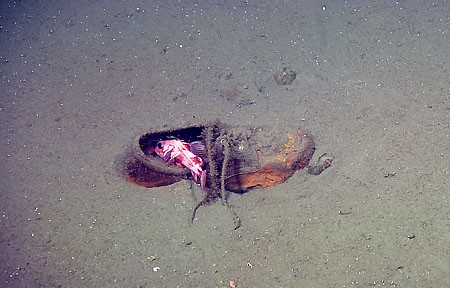Image credit: © 2010 MBARI.
We’ve all heard about the vast amounts of plastic accumulating the Great Pacific Garbage Patch. We’ve all seen trash washed up on our beaches. But what about below the surface, out of sight for any normal person? For most of us, this question has remained a mystery.
Now, a paper by researchers at the Monterey Bay Aquarium Research Institute (MBARI) shows that large amounts of trash is also accumulating in the deep sea, particularly in Monterey Canyon.
Kyra Schlining, lead author on this study, said, “We were inspired by a fisheries study off Southern California that looked at seafloor trash down to 365 meters. We were able to continue this search in deeper water—down to 4,000 meters. Our study also covered a longer time period, and included more in situ observations of deep-sea debris than any previous study I’m aware of.”
Extensive Research, Extensive Data
The study was extensive, to say the least. Schlining and her coauthors combed through 18,000 hours of underwater video collected by MBARI’s remotely operated vehicles (ROVs). Over the past 22 years, technicians in MBARI’s video lab recorded virtually every object and animal that appeared in these videos and catalogued them in MBARI’s Video Annotation and Reference System (VARS).
Research technicians the searched the VARS database to find every video clip that showed debris on the seafloor, what the debris was, as well as when and where this debris was observed. In total, the researchers counted over 1,500 observations of deep-sea debris from Vancouver Island to the Gulf of California, and as far west as the Hawaiian Islands.
In the recent paper, the researchers focused on seafloor debris in and around Monterey Bay—an area in which MBARI conducts over 200 research dives a year. In this region alone, the researchers noted over 1,150 pieces of debris on the seafloor.
The Debris
Making up about 1/3 of the of the debris -the largest proportion- were objects made of plastic. Of this, more than half were plastic bags, which are potentially dangerous to marine life because they can smother attached organisms or choke animals that consume them.
Metal objects were the second most common type of debris. About 2/3’s of these objects were aluminum, steel, or tin cans. Other common debris included rope, fishing equipment, glass bottles, paper, and cloth items.
The researchers also found that trash was not randomly distributed on the seafloor. Instead, it collected on steep, rocky slopes, such as the edges of Monterey Canyon, as well as in a few spots in the canyon axis. The researchers speculate that debris accumulates where ocean currents flow past rocky outcrops or other obstacles. The researchers also discovered that debris was more common in the deeper parts of the canyon, below 2,000 meters (6,500 feet).
“I was surprised that we saw so much trash in deeper water,” Schlining commented. “We don’t usually think of our daily activities as affecting life two miles deep in the ocean.” Schlining added, “I’m sure that there’s a lot more debris in the canyon that we’re not seeing. A lot of it gets buried by underwater landslides and sediment movement. Some of it may also be carried into deeper water, farther down the canyon.”
In the same areas where they saw trash on the seafloor, the researchers also saw kelp, wood, and natural debris that originated on land, leading them to conclude that much of the trash in Monterey Canyon comes from land-based sources, rather than from boats and ships.
Although the MBARI study also showed a smaller proportion of lost fishing gear than did some previous studies, fishing gear accounted for the most obvious negative impacts on marine life. The researchers observed several cases of animals trapped in old fishing gear.
Going Forward
MBARI researchers hope to do additional research to understand the long-term biological impacts of trash in the deep sea. Working with the Monterey Bay National Marine Sanctuary, they are currently finishing up a detailed study of the effects of a particularly large piece of marine debris—a shipping container that fell off a ship in 2004.
Schlining noted, “The most frustrating thing for me is that most of the material we saw—glass, metal, paper, plastic—could be recycled.”
Schlining and her co-authors hope that their findings will inspire coastal residents and ocean users to recycle their trash instead of allowing it to end up in the ocean.
“Ultimately, preventing the introduction of litter into the marine environment through increased public awareness remains the most efficient and cost-effective solution to this dilemma,” they wrote in the conclusion of their article.
http://www.youtube/watch?v=mOZngsJU2k0

 Join The Club
Join The Club











